
BANGKOK: AS expected the AV4 will be painted in the Armed Forces digital camouflage when the 20 vehicles contracted are delivered into service.
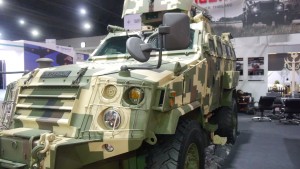
The digital camoed AV4 is making its public debut at the Chaiseri stand at the Thai Defense and Security show which starts tomorrow here in the capital of Thailand.
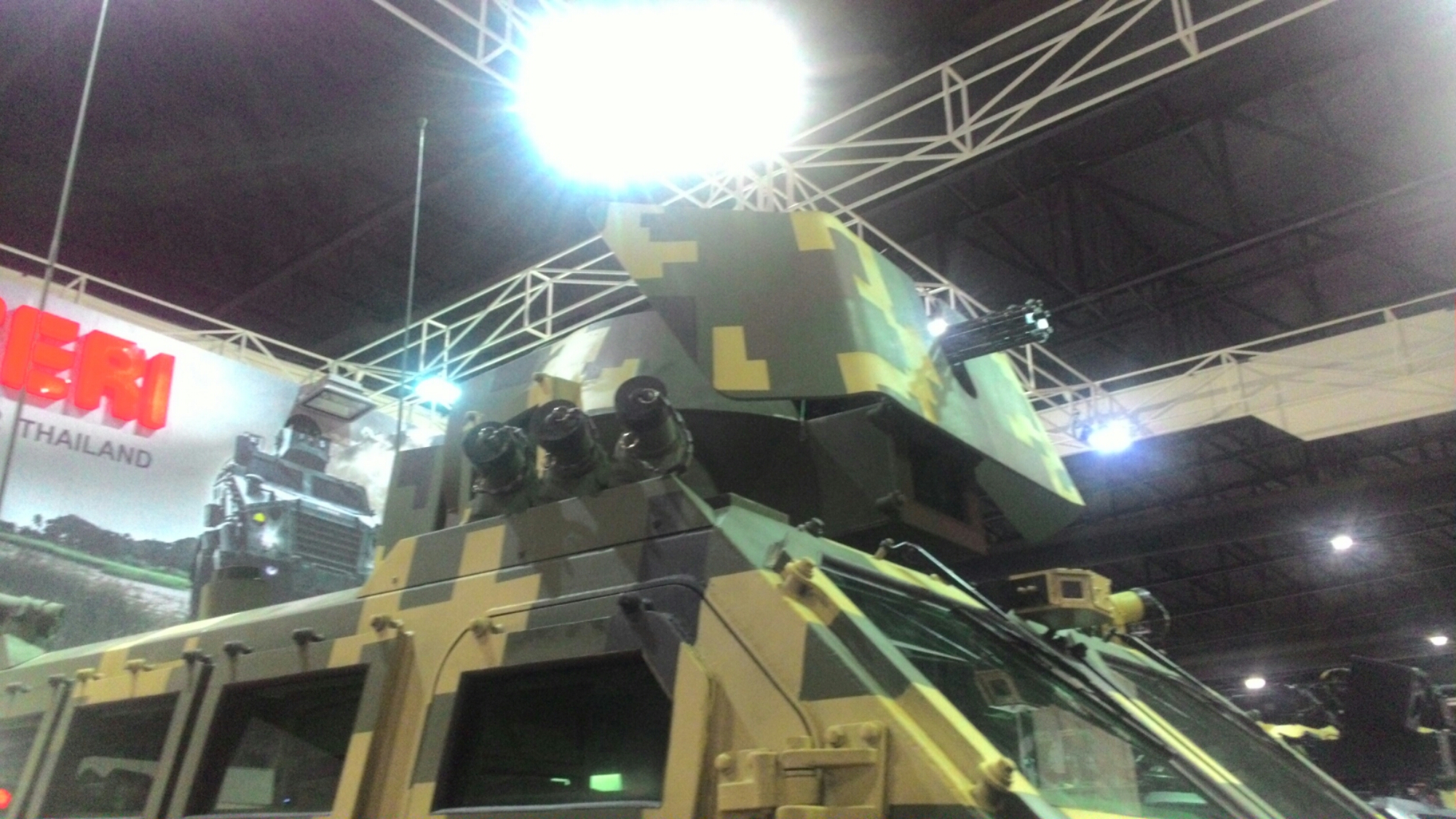
The vehicle is featured with a one man turret armed with a 7.62mm mini-gun with what appears to be a 1000 round ammo box at the back.
Parked next to the AV4 is its smaller PDRM AV4 version, which is armed with a RCWS armed with a 50 calibre machinegun.
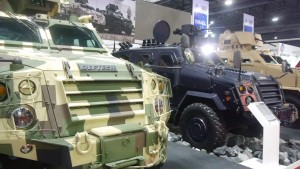
It is not yet known whether or not Deftech, Chaiseri’s Malaysian partner will be able to sell this version to the police as the force had signed up for eight IAG Jaws at the recent GPEC 2015 show in Kuala Lumpur recently.
When met today (Nov 2), Army chief Jen Tan Sri Raja Affandi Raja Mohammed Nor confirmed that the AV4 displayed at the show was the configuration of the 20 vehicles being procured for ESSCOM duties.
He said not all of the AV4s will be fitted with the mini-guns, with the majority being fitted with 12.7mm HMGs and GPMGs. The AV4s will be a welcome addition to Army units operating in ESSCOM, some of which had been using KIFvs for daily patrols.
–Malaysian Defence
If you like this post, buy me an espresso. Paypal Payment

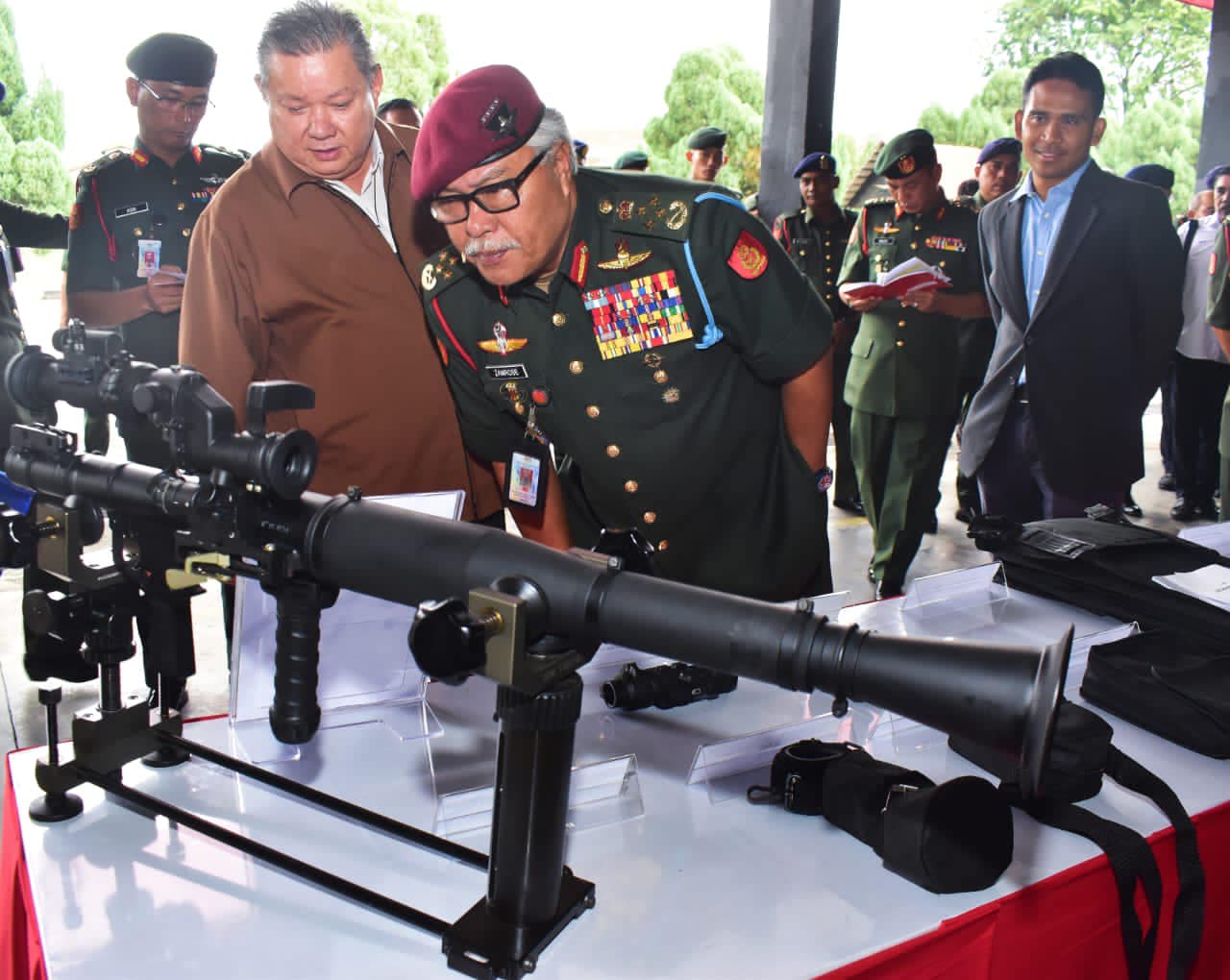
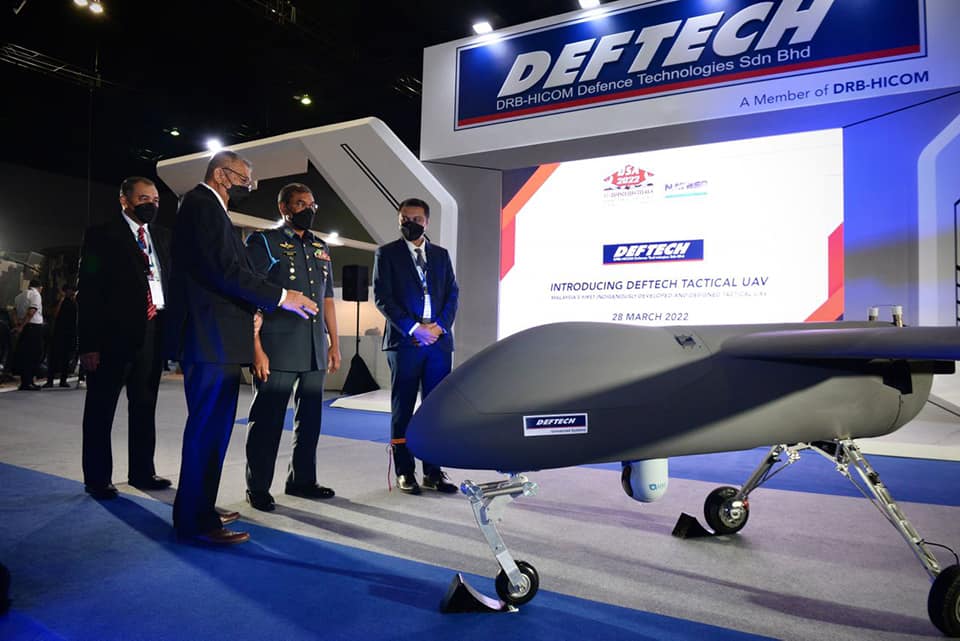
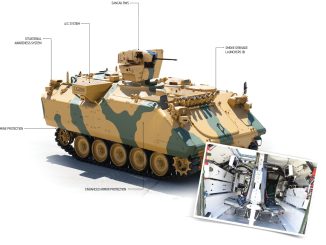
Is the minigun the new fetish in the ATM?
Reply
Yes..
Who ideas is it to fit all armed force vehicle with miniguns. Are they watched too much movies or what!! The rcws with all night vision and flir is much more useful in the combat
7.62mm minigun?never see this kind of setup before for a 4-wheeler APC. Single barrel GMPG or HMG is a norm. I believe a HMG is better for its greater range and penetrating power compared to GPMG but why this 7.62mm minigun is beyond me.
4-wheeled APC for PDRM, lately the 3 newbies (from South Korea,Polaris,Jaws) went to UTK. Maybe its high time to change the venerable V-100/200 of PGA Armoured department to AV4.
I was hoping to see AV4 with RWS mounted.
The miniguns is an added punch in terms of firepower. Whereas a gpmg n hmg can spew hundreds of rounds in a minute, the miniguns can empty the 1,000rounds in only half the time. There is nothing better for fire supressing n winning tge firefight than a mini gun. Miniguns have been fixed on rapid reacyion vehicles, 4 x 4 etc but most commonly on yop of mraps. Lets say.they just ewuip 5 vehicles with miniguns n on patrol a mixture of miniguns, gpmg n heave machine gun. The munigun can ein the firefight leaving tge gpmg n heavy machine gun to do the real damage. If i am the enemy eith the high volume of fire poured on me i will also leg it
Whether or not a mini gun on the
AV-4 is a better choice compared to a GPMG and a HMG is academic and depends on the type of targets the gunner is expected to fire upon. An advantage a mini gun would have over a GPMG and a HMG is that it is less likely to overheat when conducting sustained fire.
More importantly – rather than concerning ourselves over what the AV-4 will be armed with – will the vehicle commander and driver have thermals? Are spall liners standard fit or optional? On paper it would seem that the AV-4 is perfect for replacing the police’s Saxons and V-100/150s.
I am curious. Is that MIFV Cupola on top of AV4? Is that little thing in front of Cupola is the OBRA-3 Laser warning system?
Reply
Yes it’s very similar to the MIFV. Yes it’s very similar but the final configuration is not yet final
High rate of fire sounds great and can be useful but comes with a penalty : the need for units to constantly be restocked with ammo to feed their high rate of fire weapons. In engagements, such as encountered in Lahad Dato or during the 2nd Emergency tended to be brief or sporadic – ammo resupply was less of a problem; assuming off course that ammo reserves are nearby and that there are the means to bring them forward.
In high intensity, protracted ops, where ammo usage is higher and when enemy actions or other factors can make ammo resupply difficult; having weapons with high rates of fire can be a liability. We have been lucky in that in all the engagements we fought (2nd Emergency, Confrontation, Somalia and Lahad Dato) were against non peer adversaries and that ammo resupply was never a major issue; due to various factors.
P.S. It would be interesting to know how much ammo was carried by the men in Barkara Market and by the Condors. All accounts speak of thousands of rounds fired from the moment the convoy was engaged to the moment it left Bakara Market with Americans on board and others following on foot.
How much ammo did the convoy have left by the time it regrouped at the stadium? Had the convoy been trapped and has been unable to leave; would ammo have run out? Another unanswered question is whether the convoy included any 20mm armed Condors. I have yet to see a pic of a 20mm armed Condor with MALBATT in Somalia.
Miniguns are fun but they are a poor choice for anything other than very specific tasks. They require power, take time to spool up and are difficult to reload once you burn away your ready hopper. They also do not dismount and are invariably less accurate as you are freegunning. So no, having them in the gun tub for an MRAP is not a great idea but hey, asalkan gaya.
The ACAV gun tub tells me it is repurposed from a KIFV or the like. Situational awareness in those is garbage.
The configuration — minigun and MG look fine to me if we’re looking at Esscom.
Like it says on the tin, this vehicle is a form of transport; it’s not meant to fight, like IFV or tanks. The main thing is to carry troops and move around — and hopefully survive any mines/IEDs and ambushes along the route. If there’s contact, the important thing is to dismount the soldiers who will do the actual fighting. Like Lee says, a weapon that can lay down heavy fire will be helpful in keeping the enemies’ head down while the troops dismount, and nothing can beat a gatling gun at this job.
I hope the Kirams have not acquired laser guided weapons to necessitate a laser warner on the vehicle. I doubt they’ve got the capability to land in Sabah in numbers and with ‘technicals’ for a Bukhara Market scenario.
Off topic, while the film ‘Bravo’ was a great initiative for war film in the country although its overall quality and story line were disappointing, I am sure a lot of us would love to see another war film of our troops in action in more recent time such as in Mogadishu. Only this time, please let those real professional film makers do it. Now who say action movie can’t sell, ask Zahirah..
Azlan,
An officer, Syed Othman, who was commissioned in19 RMR and who lost his sight after a booby trap incident in Emergency II, has written a self-published account of 19 Malay’s tour in Somalia in ’19 RAMD Mekanis di Somalia’. ISBN 983-99021-0-5.
The operation was under US command, had a mix of vehicle weapons — 20 mm Oerlikon and twin 7.62 GPMG. They carried US dismounts, had one and a half first-line ammo for men and vehicle, but an officer had to ‘borrow’ a couple of M-16 magazines from an American when they were on the ground. 19 RMR lost 4 vehicles — 3 twin GPMG and a 20 mm. One of those was later destroyed by a US heli to prevent militia from getting the vehicle’s weapons. APCs with punctured tyres – a partial ‘M’ kill, I think — made it to safety under own power but had to be left at a friendly checkpoint to recovered later.
19 RMR had a sprinkling of night vision goggles; the Pakistani tank troop didn’t and used that excuse to chicken out from leading the column, and perhaps even sending another troop to the rescue. There was no mention of tanks leading the withdrawal in the morning. This was not the first time they cabut. In an earlier incident at the court house, they escorted a UN delegation and scooted out of the area pronto leaving a platoon of 19 RMR with their vehicles to guard and later extract them when the court building came under attack from militia holed up in nearby buildings.
The account is good reading for those who underestimate the value of firepower in what is effectively FIBUA/MOUT, and I think lessons learnt have not been lost on TD: 2 vehicles, a GPMG and an Oerlikon, combined to take out a HMG nest on top of a 4-storey building that was preparing to fire on helis. Covering fire is important when dismounting. Three US Rangers were hit immediately after exiting a Condor, the effect of not being able to put down effective covering fire, even from twin GPMG and perhaps the rear gunner as well.
There’s even an intersting lesson on cultural differences: when ordered by an American to advance down a narrow lane while under fire, a Malaysian driver hesitated for fear of running over the bodies of dead Somalis — he’d asked the Yanks to clear the road of bodies first which the Yanks understandably declined to do. All this while under HMG and RPG fire.
1000 rounds though.. for a minigun that’s like “lekat celah gigi”. Liked stan’s explanation better.
Ferret,
Thanks for the info. Will try get the book.
According to what I read, vehicle crews were told to avoid ramming into makeshift Somali roadblocks as the Somalis had a habit of mining them.
Another problem was conflicting orders given to Condor crews by Malaysian and American officers.
Language to some extent was a problem. Quite a few of the lower ranks had English issues and had problems communicating with the Americans.
I can only hope that the proper lessens were learned from Bakara Market (and Lahad Dato). Sure we did several things right but there were also areas where we could have done better. I just finished reading a book about Goose Green. It seems that things did not go do well for 2 Para as we have been led to believe. For the sake of the regiment many officers were less than candid/ truthful about what really happened. The British practice of micro managing things or keeping company commanders on a tight leash didn’t help and after the death of the battalion CO his 2nd in command adopted a more flexible command approach.
nak tanya..turret yg di pasang atas av8,av6 tu guna sistem apa?..mcm jhcms jugak ke?
p/s: sori,tak pandai BI
In an infantry fire fight, especially in an ambush there are various stages to a firefight.
1). Identify location of enemy
2)winning the firefight
3)assaulting the enemy
4)search
5) regroup
Its no use if we cant even see the enemy . So we must identify where we are bring shot. Then the leader can call out to stop all firing n issue his fire order. Then everyone must let loose. During the emergency days, those fortunate venue ough to get into a contact will tell you that its not funny bring shot at. Morale would sink to the bottom especially if one cant see where is the enemy. But once they hear the chatter of the lmg or the gimpy, their morale will return n they will start firing their weapons. No one will be sure. They will just let go. Hit or no hit does not matter. Just shoot back. Pour as heavy a fire as one can into or atound the enemy to keep their heads down. This period also allows the leader a bit of time to do battle appreciation .
Walking, no one can bring heavy equipment like the minigun. But for vehicle borne patrols they can. For sheer volume of fire nothing can beat a gatling gun. In vehicle ambushes, we were taught to jump down n look for cover. But this tactic met with a disaster. The commies observed our tactic. On the next ambush every soldier who jump down got shot. Those that remained in the lorry survived. So armoured protection is cery important . If the vehicle can lay down tons of fire n keep the enemys heads down, the disembarking troops s are protected
satu lg soalan..apa beza minigun kt av4 ni dgn gatling gun yang dipasang kat aw109 tu?
Reply
Its the same thing, probably it will be taken out from the AW109s…
Lee,
Even in vehicles, having adequate ammo supply can be a problem; especially when conducting high intensity ops where high rates of fire are the norm. Only so much spare ammo can carried inside a vehicle, which to start with is already cramped and carrying other vital stuff. Despite its high rate of fire a mini gun does not provide all the answers or is not a panacea. It’s only good when used with other assets and employing maneuver. Viewed objectively, a high rate of fire can has its advantages but can also be a liability.
High ammo usage rates was rarely a problem during the 2nd Emergency as the bulk of engagements did not last long and Chin Peng’s goons themselves had ammo issues and usually withdrew after a while to avoid being fixed. In a future conflict, things could be different ……..
Ariff,
JHCMS ???? Joint helmet for what?
Two vatious turret is installed on AV8 (the LCT30 by Denel,Sharshooter turret)
Gents,
Minigun of course have devastating impact for like what 30/40 sec. Then ?? But as seen in Iraq or Afghan, firepower, suppresive fire is not the issue. The issue is locating em. This is no more commies era ambushing truck while shooting just beside the truck. They fire from the hills, far away. Asymmetrical warfare. And the most challenging is for the gunners to locate em with their mk1 eyeballs and ear. Supressive fire for what when you cant even know where the enemy is ? This is the era of protected vehicles, soldiers is sitting inside the protected trucks while rcws and sniper detection system (eg:Boomerang) scan for the terrain for the enemy and shooting at em, after then, disembark.
Reply
Actually its three turrets, you forgot the LCT30 with the ATGM one. Unfortunately due to various operational issues and costs, not many gizmos will be on board.
Irrespective of advances in technology; terrain plays a vital role and determines everything. To dominate terrain and other objectives; troops will still have to eventually dismount. In restrictive terrain the well being of AFVs will depend on the quality of infantry cooperation it gets. The problem – whether the AFV is a Marder or a Terrex; is the the number of troops that can be carried.
The way our army goes about doing things (from tactics, to restrictive command orders above battalion level, etc) is still coloured by its experiences from the 2nd Emergency which is ingrained in the army’s psyche as a whole. Sure, a lot of lessons from that period still apply today but not all as the circumstances and adversaries we may face in the future will be different. We can only hope that the various training establishments are keeping up with the times and are not drawing the wrong lessons or lessons that don’t apply to us from Iraq, Afghanistan and other conflicts.
For me the most important element in the ATGW variant is the 360 degrees sight.
Irrespective of advances in technology; terrain plays a vital role and determines everything. To dominate terrain and other objectives; troops will still have to eventually dismount. In restrictive terrain the well being of AFVs will depend on the quality of infantry cooperation it gets. The problem – whether the AFV is a Marder or a Terrex; is the the number of troops that can be carried.
The way our army goes about doing things (from tactics, to restrictive command orders above battalion level, etc) is still coloured by its experiences from the 2nd Emergency which is ingrained in the army’s psyche as a whole. Sure, a lot of lessons from that period still apply today but not all as the circumstances and adversaries we may face in the future will be different. We can only hope that the various training establishments are keeping up with the times and are not drawing the wrong lessons or lessons that don’t apply to us from Iraq, Afghanistan and other conflicts.
For me the most important element in the ATGW variant is the 360 degrees sight.
This is not bakara market. Neither is ot afghsnistan. Its sabah, sarawak n peninsular malaysia. Who says there were no issues eith ammo for emergency n confrontation?. During particularly fierce contacts, many of our men have ammunition issues. Some will just let go especially once m16 has been introduced. How many bullets are issued 200 rounds per man n 6 mags. At full auto the 6 nags can be finished in less than 2 minutes n uet not hit anything. Now firepower is the crucial factor as tge firefight must be won. The fire need not hit any rnemies. It need not have to last long. Firepower is everything. Of course, in a vehicle ambush, its to run out of the killing zone but a carefully laid ambish eould block the road. So firefight cant be run away from.
Lee,
When I said that ammo was not an issue I was not referring to people literally running out of ammo in a contact. I was referring to things at a higher level : we never reached a stage where units could not operate because of lack of ammo or a stage where we could not resupply units in the field – for whatever reason – to the extent that the unit was not combat effective.
Firepower by itself is useless without other factors like maneuver and proper command tactics. If firepower was everything or was a panacea; then all vehicles would be armed with a mini gun. Note that I did not totally discount the need for “firepower”.
I’m aware that this is not Somalia or Afghanistan but certain lessons there can be applied here. There are also certain lessons learned there that can’t be applied here.
AV4 camo tone looks different compared to the ones on active duty. Lighter and not much pixelled. It reminded me of the Wehrmacht armour&halftrack camo in Western Front.
Reply
Probably because its done by Chaiseri instead of the Army boffins at PD.
When I looking for information about Malaysian First Win a.k.a Deftech AV4, I found that our MRAP is 2+1 door configuration, instead 4+1 in original Chaiseri First Win. Can anyone explain, please? And I hope this MRAP will have some common part with our AV8 Gempita for ease of maintenance and logistic, tire or smoke grenade or passenger seat or steering/dashboard maybe, to name a few…
Sorry, late again, but interesting discussion about ambushes and firepower.
I totally agree with Lee’s points. Of course Lee is right about firepower. He and I were only agreeing with the PTD — who I imagine would have had the staff work on the matter done — when he mentioned firepower and mobility as important for the TD.
Sure, the basic thing about counter-ambush tactics is to find out where the fire is coming from first before laying out the covering fire.
But a good patrol commander would have done a map recce to study the ground, take into account enemy tactics, identify the potential ambush areas, and plan his patrol accordingly. In fact, he would have put himself into the enemy’s head and rehearse ambushing his patrol on the map. In close country he could even dismount troops to provide flank protection. These are all tactics of course, which would change according to the situation.
Generally speaking, there would also be CAS (or even arty) on call if things get sticky. In Sabah, I would imagine there would be CAS in support if called for especially with the new a/c we\’re getting.
—–
The C2 in Bakhara Market was cocked-up from the start. Unosom HQ was not informed early of the planned US op. US forces involved were not part of Unosom. 19 RMR was asked to do the job because it was Unosom’s RDF. The Americans wanted to carry their men, so half of A and B coys 19RMR were left out. The Pakistani tanks were not ready, so the rescue and subsequent fighting had to be done at night. The order of march broke the basic rules, I think — who would put APC in the van with tanks in the main body in a built-up area and at night?
—–
There is nothing wrong about retaining lessons learnt during the Emergencies and being influenced by them. COIN has only become flavour of the decade after Afghanistan and Iraq only because NATO had to relearn CIW and fight the ‘Long War’.